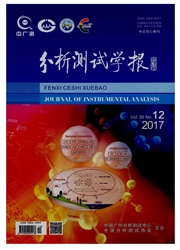

 中文摘要:
中文摘要:
使用金纳米粒子为增强因子的表面增强拉曼光谱技术,通过连续小波变换将拉曼光谱信号转化到小波空间(墨西哥帽小波作为小波基)。该步骤能够减轻信号中基线变化及随机噪音的影响并找到峰位置和最佳小波尺度系数。依据小波空间中的信息,对混合物光谱及标准谱光谱进行反向搜索得到反向搜索匹配系数(Reverse match quality,RMQ),作为判断混合物中目标成分是否存在的依据。该算法可对混合物中的目标物质进行准确定性,并已成功应用于多种食品中色素鉴定。食品中色素的检出率达到99%,且结果稳健,其效果明显优于传统的命中质量系数法(Hit quality index,HQI)。这证实了小波空间反向搜索方法是一种快速而准确的拉曼光谱定性算法。
 英文摘要:
英文摘要:
In this study, a gold nanocrystal colloid was used as the enhancement factor for surface- enhanced Raman scattering(SERS). Raman spectra were transformed by continuous wavelet transform (CWT) , and Mexican hat wavelet were chosen as the wavelet basis. This procedure could be used to alleviate the influence of baseline variations and random noise, and find peak positions and the best scale wavelet coefficients of signal. Reverse search method was proposed to compare the spectrum of an unknown sample with a spectrum of standard using the information in wavelet space. Reverse match quality(RMQ) could be obtained automatically to determine whether a substance is present. It was used to identify colorants in a variety of food successfully. The colorants could be identified with 99 percent accuracy. It shows a better performance compared with traditional hit quality index (HQI). The study confirmed that the wavelet-based reverse search is feasible and accurate in qualitative analysis.
 同期刊论文项目
同期刊论文项目
 同项目期刊论文
同项目期刊论文
 期刊信息
期刊信息
